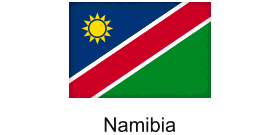 Namibia's Rail expansion and green energy initiatives
Namibia's Rail expansion and green energy initiatives
Dr Helvi Petrus from the Transportation Commission of Namibia presented on both Namibia’s internal and cross-border regional rail network at the African Union Commission (AUC)’s Department of Infrastructure and Energy (IED) Continental Workshop. The event, which focused on the implementation of the Africa Integrated Railways Network (AIRN), took place from 7th to 10th May 2024 in Dar es Salaam.
Namibia aims to become a logistics hub. The national strategy focuses on accelerating the implementation of the rail network to ensure connectivity within Namibia and link the landlocked country to the international market. This goal requires active engagement of all transportation modes to support logistics and trade within the nation and the region.
National Perspective and Rail Network Development
From a national perspective, Namibia has established several corridors to facilitate trade. These corridors connect neighbouring countries to the port of Walvis Bay, a crucial point for international trade. Key corridors include:
Walvis Bay-Ndola-Lubumbashi Development Corridor: Connecting the Democratic Republic of Congo (DRC) and Zambia to the port of Walvis Bay. Trans-Kalahari Corridor: Linking the port of Walvis Bay through Botswana to South Africa, or vice versa. Trans-Cunene Corridor: Connecting Namibia and Angola. Trans-Oranje Corridor: Connecting Namibia to the Western Cape in South Africa.
To support its logistics hub vision, Namibia has expanded the port of Walvis Bay to accommodate more port activities, including vessels that previously could not dock due to limited facilities. Additionally, the development of an oil storage facility within the port’s vicinity further enhances its logistics capabilities. Namibia also offers dry ports to landlocked countries, facilitating trade activities through Walvis Bay.
Namibia and the Africa Integrated Railways Network (AIRN)
Namibia features prominently in both the AIRN master plans for 2033 and 2043, with pilot projects designated as links 35 to 37 and links 53 and 59, respectively. The country has made significant progress in rail development, including a pre-feasibility study conducted in 2021 under a bilateral agreement between Botswana and Namibia, later extended to South Africa.
In 2014, Namibia established the Project Management Office (PMO) to facilitate the implementation of the Trans-Kalahari Railway project. This office, based in Windhoek, includes technical representatives from Namibia and Botswana, with South Africa expected to join. The PMO works in coordination with a joint technical committee and a joint steering committee, reporting to a joint ministerial committee that communicates with SADC heads of state.
Achievements and Implementation Framework
Significant milestones include:
November 2010: Signing of the Memorandum of Understanding (MoU) between Botswana and Namibia. March 2014: Pre-feasibility study completion and bilateral agreement. September 2014: Establishment and operationalisation of the PMO, appointing technical officials from both Botswana and Namibia. 2016: Conducting the Trans-Kalahari Rail Development Study.
Policy and legislative frameworks govern the PMO’s operations. In 2023, the focus shifted to the implementation plan, seeking funding on a public-private partnership (PPP) level. Namibia is now evaluating expressions of interest to appoint an interested party for project implementation, with assistance from consultants.
Challenges and Opportunities
Namibia faces several challenges, including insufficient rail infrastructure, dilapidated rail lines, lack of adequate rolling stock, institutional constraints, and funding limitations for rehabilitating existing networks. Despite these challenges, Namibia sees significant opportunities:
Green Hydrogen: Projects include converting traditional locomotives to hydrogen-powered trains and establishing a multimodal hydrogen fuel station through a bilateral agreement with Belgium. Hydrogen-Powered Ships: Namibia plans to launch Africa’s first hydrogen-powered ship next year. Renewable Energy: Leveraging solar energy for manufacturing and supplying rail infrastructure and rolling stock.
Namibia aims to benefit from the rail industry’s value chain and identified green hydrogen projects. Political support from the governments of South Africa, Botswana, and Namibia bolsters these efforts. The country is also exploring the feasibility of transporting additional commodities by rail, beyond coal.
